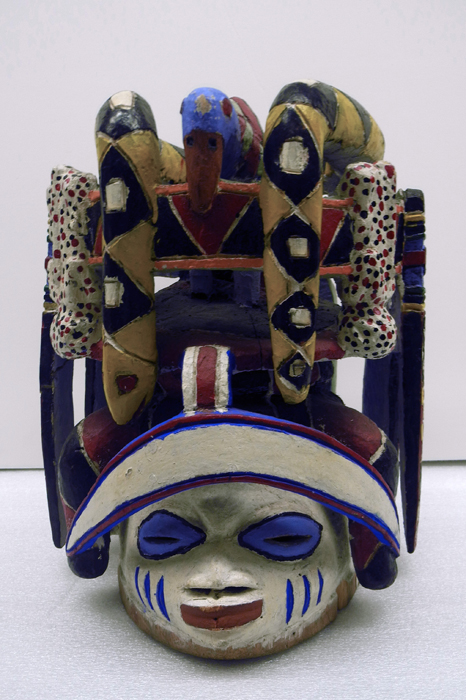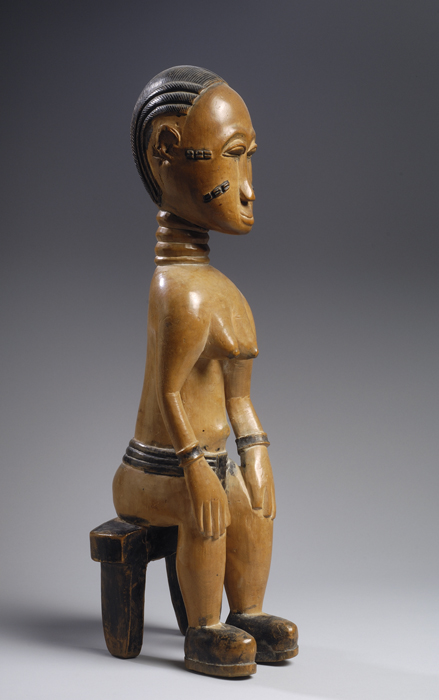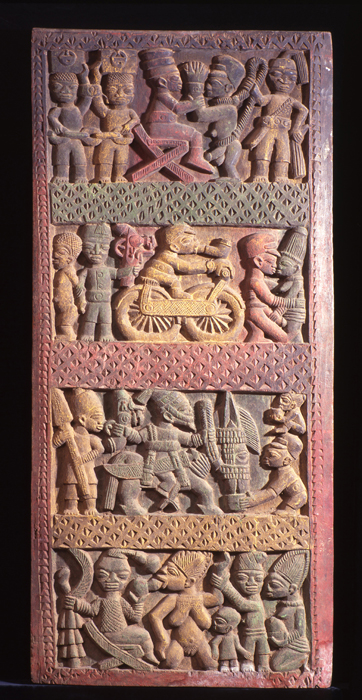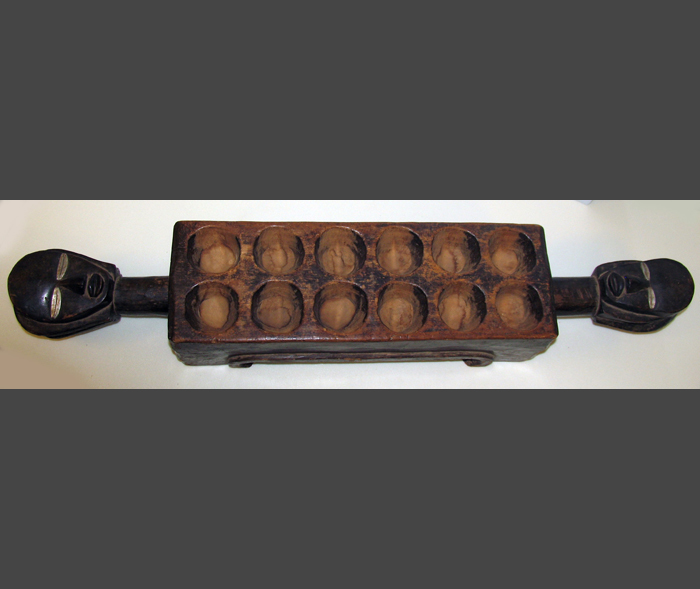Background
Africa is a vast continent with much geographic and cultural diversity. The visual arts are equally diverse. Artists have long experimented with, incorporated, and adapted new subject matter, motifs, materials, and forms introduced by explorers, traders, and colonizers into traditional ones. (Likewise, as outsiders returned to their homelands with art and objects from Africa, African art influenced the art of other cultures.)
Many traditional African artworks and objects served a social purpose that was communicated through the visual imagery and form. The surface of an object may hint at its original use and purpose. For instance, nails may have been added to a figure imbued with certain powers for healing purposes or for taking an oath. Proportions often reveal conceptual significance, with a larger scale implying more importance. The stance and/or facial expression of a figure might hint at the object’s symbolic meaning. Decoration, adornment, and added details on a carved or sculpted figure may indicate prestige or cultural norms or preferences. You may notice, for example, scarification (the scarring of the skin with patterns) on a figure’s face or jewelry embellishing the figure. The use of valuable materials may also be a sign of wealth, royalty, or status, or offer clues about trade with different cultures. Colors and patterns are often symbolic as well, but you will have to research the particular culture that made the artwork, object, or textile to determine the specific meaning.
Questions
- What do you think is the significance of the surface texture, decoration, or embellishments on an object or figure? What might this tell you about the work’s purpose? What might this tell you about the culture the work is from? Why do you think this?
- What do the proportions suggest is conceptually most important?
- Why do you think part of a figure’s body was made proportionally larger in scale? What could this mean?
- What do the proportions signify about the relationship between different figures? What do you think this could mean?
- What do you think was the original purpose or use of the art object? Where was it used? When and by whom? Why do you think this?
- What do you think the imagery, materials, or form could tell you about the history of interaction between the African culture and others?
- Often there is no individual artist attributed as the creator of the work, and no specific date provided for the work. What do you think about this? What might this lack of information reveal about the culture the work is from? What might this lack of information reveal about the individual and/or culture that acquired the work? What might this lack of information reveal about a museum’s exhibition practices?
Want to know more?
Works in the Nasher’s Collection
Exhibitions at the Nasher Museum
The Collection Galleries (ongoing)
Pedro Lasch, Susan Harbage Page and Yinka Shonibare (July 20 – Dec. 1, 2013)
Wangechi Mutu: A Fantastic Journey (March 21 – July 21, 2013)
Africa and Picasso (Aug. 20, 2009 – Jan. 10, 2010)
Bibliography
Bassani, Ezio. Arts of Africa: 7000 Years of African Art. Milan: Skira; Monoco: Grimaldi Forum Monaco, 2005.
Blier, Suzanne Preston. The Royal Arts of Africa: The Majesty of Form. New York: H.N. Abrams, 1998.
Enwezor, Okwui. Contemporary African Art since 1980. Bologna: Damiani, 2009.
Enwezor, Okwui, and Olu Oguibe, eds. Reading the Contemporary: African Art from Theory to the Marketplace. Cambridge: MIT Press, 1999.
Hassan, Salah, and Olu Oguibe, eds. Authentic, Ex-Centric: Conceptualism in Contemporary African Art. Ithaca: Forum for African Arts; Prince Claus Fund Library, 2001.
Kasfir, Sidney Littlefield. Contemporary African Art. London: Thames & Hudson, 2000.
McNaughton, Patrick, and Diane Pelrine. “Art, Art History, and the Study of Africa.” In Oxford Bibliographies in African Studies.
Meyer, Laure. Art and Craft in Africa. Paris: Terrail, 2007.
Milbourne, Karen E. Earth Matters: Land as Material and Metaphor. Washington, DC: National Museum of African Art, Smithsonian Institution; New York: Monacelli Press, 2014.
Nka: Journal of Contemporary African Art. Brooklyn: NKA Publications.
The Scala Group. African Art: The Visual Encyclopedia of Art. Scala lnternational: Welcome Rain, 2013.
Visual Century: South African Art in Context. 4 vols. Johannesburg: Wits University Press; Oslo: Visual Century Project, 2011.
Willet, Frank. African Art. London: Thames & Hudson, 2002.
Art of the African Diaspora:
Ferrell, Laurie Ann, ed. Looking Both Ways: Art of the Contemporary African Diaspora. New York: Museum for African Art, 2003.
Mercer, Kobena, ed. Exiles, Diasporas & Strangers. Cambridge: MIT Press, 2008.
Mercer, Kobena, ed. Pop Art and Vernacular Cultures. Cambridge: MIT Press, 2007.
Nuttal, Sarah, ed. Beautiful Ugly: African and Diaspora Aesthetics. Durham: Duke University Press, 2006.
Powell, Richard J. Black Art: A Cultural History. London: Thames & Hudson, 2002.
Thompson, Robert Farris. Aesthetic of the Cool: Afro-Atlantic Art and Music. Pittsburgh: Periscope, 2011.
Thompson, Robert Farris. Flash of the Spirit: African and Afro-American Art and Philosophy. New York: Vintage Books, 1984.






